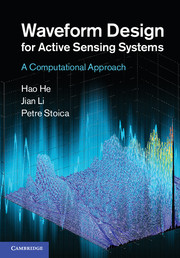Book contents
- Frontmatter
- Contents
- Preface
- Notation
- Abbreviations
- 1 Introduction
- Part I Aperiodic correlation synthesis
- 2 Single aperiodic sequence design
- 3 Aperiodic sequence set design
- 4 Lower bounds for aperiodic sequences
- 5 Stopband constraint case
- 6 Ambiguity function (AF)
- 7 Cross ambiguity function (CAF)
- 8 Joint design of transmit sequence and receive filter
- Part II Periodic correlation synthesis
- Part III Transmit beampattern synthesis
- Part IV Diverse application examples
- References
- Index
3 - Aperiodic sequence set design
from Part I - Aperiodic correlation synthesis
Published online by Cambridge University Press: 05 August 2012
- Frontmatter
- Contents
- Preface
- Notation
- Abbreviations
- 1 Introduction
- Part I Aperiodic correlation synthesis
- 2 Single aperiodic sequence design
- 3 Aperiodic sequence set design
- 4 Lower bounds for aperiodic sequences
- 5 Stopband constraint case
- 6 Ambiguity function (AF)
- 7 Cross ambiguity function (CAF)
- 8 Joint design of transmit sequence and receive filter
- Part II Periodic correlation synthesis
- Part III Transmit beampattern synthesis
- Part IV Diverse application examples
- References
- Index
Summary
Chapter 2 dealt with designing a single sequence with good auto-correlation properties. In a similar way, in many applications a set of sequences that have good correlation properties is desired, for example in MIMO (multi-input and multi-output) radar and CDMA (code division multiple access) systems. When transmitting orthogonal waveforms, a MIMO radar system can achieve a greatly increased virtual aperture compared with its phased array counterpart. This increased virtual aperture enables many of the MIMO radar advantages, such as better detection performance [Fishler et al. 2006], improved parameter identifiability [Li, Stoica, Xu & Roberts 2007], enhanced resolution [Bliss & Forsythe 2003] and direct applicability of adaptive array techniques [Xu et al. 2008].
In the case of waveform-set design, which is also referred to as multi-waveform design, both auto- and cross-correlations are involved. Good auto-correlation means that a transmitted waveform is nearly uncorrelated with its own time-shifted versions, while good cross-correlation indicates that any transmitted waveform is nearly uncorrelated with other time-shifted transmitted waveforms. Good correlation properties in the above sense reduce the risk that the received signal of interest is found in correlated multipath or clutter interference.
There is an extensive literature about multi-waveform design. In [Deng 2004] and [Khan et al. 2006], orthogonal waveforms are designed that have good auto- and cross-correlation properties, a topic that is directly tied to this chapter. More related to Chapters 13 and 14, [Fuhrmann & San Antonio 2008] and [Stoica et al. 2007] focus on optimizing the covariance matrix of the transmitted waveforms so as to achieve a given transmit beampattern and in [Stoica, Li & Zhu 2008] the waveforms are designed to approximate a given covariance matrix.
- Type
- Chapter
- Information
- Waveform Design for Active Sensing SystemsA Computational Approach, pp. 39 - 66Publisher: Cambridge University PressPrint publication year: 2012



